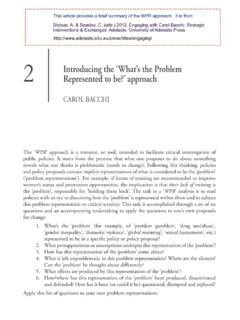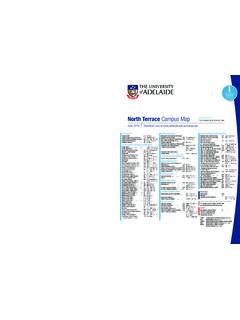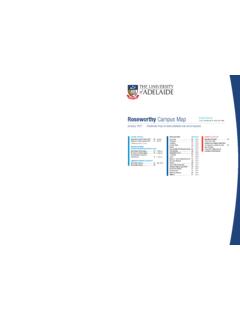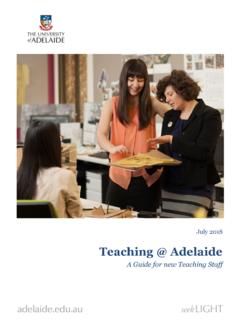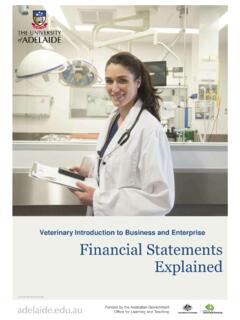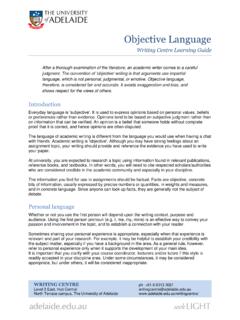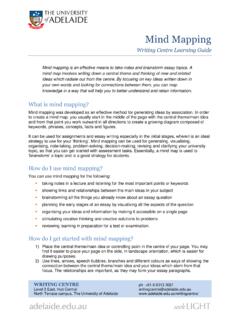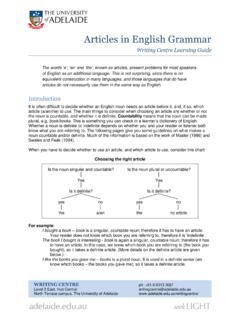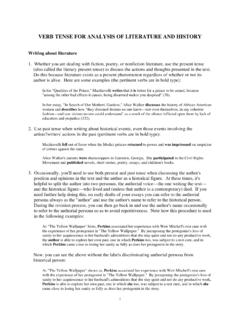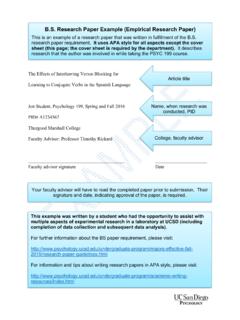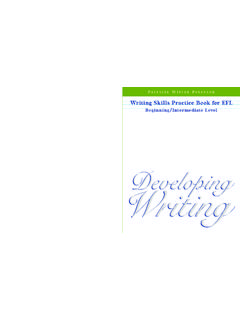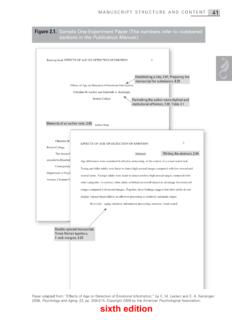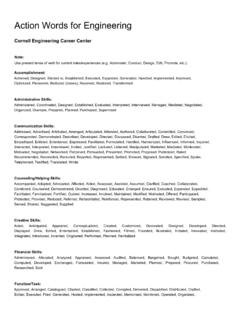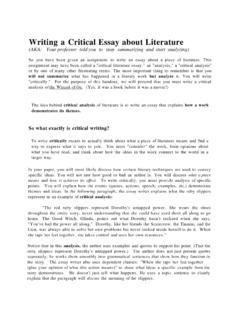Transcription of How to Write a Practical/Laboratory Report
1 How to Write a Practical/Laboratory Report Writing Centre Learning Guide The ability to Report technical information clearly and concisely is fundamental to the sciences. As such, science students are often required to prepare formal reports about experiments or investigations undertaken in the practical components of their courses. These reports must clearly communicate the aims, methods, findings and conclusions of an experiment. This Learning Guide shows you how to prepare a practical Report and provides tips for ensuring a good grade. practical Report Structure practical reports have a clear, linear structure. Table 1 shows the different sections of a practical Report and states the function of each section.
2 (Requirements for individual courses may be different.) Table 1. practical Report sections and section functions Section Function Title Clearly and concisely informs the reader of the practical Report topic (a title may be provided to you), , influence of nitrate on the nodulation of medics. Introduction (Approx. word count: 200) Provides background information needed for the reader to understand the context and purpose of the experiment. At the end of the introduction, the aim is clearly stated. Materials and Methods (Approx. word count: 300) Describes what was done in the experiment. Includes materials used and procedures followed. Results (Approx. word count: 300) Presents the findings of the experiment.
3 Discussion (Approx. word count: 500) Interprets and explains the findings, and places them in the context of background information. Conclusion (Approx. word count: 200) Summarises findings and interpretations. References Presents the sources of information used in the Report . Appendix/Appendices Provides detailed information (when necessary). Introduction The introduction gives the reader background information about the topic of the practical Report , and places your Report in the context of that background information. You should begin by summarizing what is already known about the topic. Because of this, the introduction will often need to include references.
4 The introduction should then highlight how your Report relates to the background information, , through investigating a research gap, examining the physical properties of a rock or demonstrating a scientific law. The introduction should culminate in a clear statement of the aim of the experiment. Structure your introduction to answer the following two questions: 1. What is known about this topic? 2. Why was the experiment performed? Materials and Methods The materials and methods section thoroughly describes how you carried out your experiment and should provide the reader with sufficient information to replicate the experiment. Structure your materials and methods section to provide a step-by-step account of what you did when you performed the experiment.
5 Your materials and methods section should answer the following two questions: 1. What materials were used? 2. How were the materials used? Use past tense because you are providing a description of what you did, however avoid the use of personal pronouns, , I or we. If you have been told to refer to the practical Manual for the materials and methods section, be sure to provide page numbers for the relevant experiment and include the practical Manual as a reference. Alternately, you may be required to rewrite the dot point style instructions found in your practical Manual into narrative form. For example, change Add mL aliquot of enzyme to start the reaction and incubate for 30 min at 25 oC.
6 To The reaction was started by the addition of a mL aliquot of enzyme and incubated for 30 min at 25 oC. Results The results section is where you present the data obtained in your experiment in a logical order. Depending on how much data you have, it is usually best to summarize results. Your complete datasets can be included as an appendix. It is desirable to display results using tables or figures ( , graphs or photographs). Tables and figures in the results section must be referred to in the text before the table or figure is presented (see examples below). Tables and figures must also have titles. The title belongs above a table and below a figure. Do not replicate how you present the data.
7 If data is in a table, the same data must not also be presented in a graph. Examples of presenting a figure in the results section: This study compared the memory of mice and guinea pigs using a maze with a reward at the end. Results show that mice completed the maze without error after an average of 15 attempts compared to an average of 24 attempts for guinea pigs (Figure 1). This study compared the memory of mice and guinea pigs using a maze with a reward at the end. Figure 1 shows that mice completed the maze without error after an average of 15 attempts compared to an average of 24 attempts for guinea pigs. Figure 1. Average number of attempts to complete the maze without error for mice and guinea pigs.
8 Importantly, do not include interpretations of your data in the results section. Save that for the discussion! Instead, simply present the data for what it is. Discussion The purpose of the discussion section is provide an explanation for your results and to interpret those results in the context existing theory and knowledge. Therefore, the discussion section will generally need to include references. The discussion section should cover the following points, but note that for some experiments not all of these points will be relevant: Relate results back to the aim Provide an explanation of why the experiment produced those results Compare and contrast results to findings of other research Identify problems in experimental technique or design and suggest improvement State the significance of your results and suggest areas for future research In the discussion, do not simply restate the results.
9 You must interpret the data. For example, what trends are evident in the data? What are the implications of your results? Do your results fulfil the aim of the experiment? Are there any potential errors present in the results? Think carefully about how you structure the discussion so you achieve logical flow from one topic to the next. Conclusion The conclusion summarises key results and interpretations of the experiment. The conclusion should be concise and brief. Importantly, the conclusion should not introduce any new information. 051015202530 MiceGuinea PigsAverage number of attempts to complete mazeSpeciesReferences It is standard academic practice to provide the details of references used in your Report .
10 References are required both in text and in a list at the end of your Report . Do not include information sources that you read but did not use in the Report , just include the sources you actually cite (or mention) in the Report . The reference list must be presented in alphabetical order by first author. Do not use dot points or numbers in the reference list. Generally you will be required to reference according to the Harvard referencing style, but make sure that you use the referencing style recommended by your lecturer and follow the style consistently. You can find different referencing guides on the University of Adelaide Writing Centre website: Appendices Appendices may be used to present detailed information that is not critical to the content of your Report , such as calculations or raw data.
